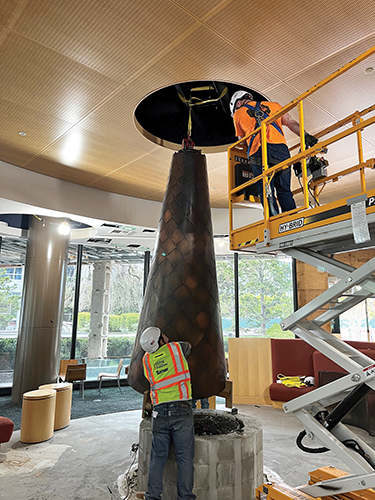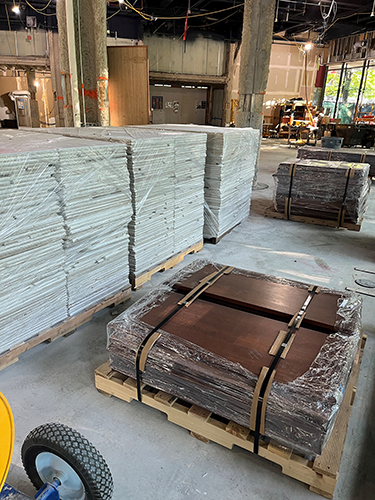|
Subscribe / Renew |
|
|
Contact Us |
|
| ► Subscribe to our Free Weekly Newsletter | |
| home | Welcome, sign in or click here to subscribe. | login |
Environment
| |
 |
April 25, 2024
A blueprint for environmental responsibility in construction
Turner

Liang
|
A commitment to sustainability was a key factor for Sterling Realty Organization (“SRO”), a real estate corporation with assets in the Puget Sound and Salt Lake City markets, in selecting Turner Construction Company as general contractor for the 35,000-square-foot renovation of the lobby and plaza areas in the Symetra Center at 777 108th in downtown Bellevue.
With deep roots in the Pacific Northwest, environmental stewardship is a high priority for SRO and one of its goals for the renovation was to focus on reusing, donating and recycling construction materials that would otherwise end up in a landfill. This vision perfectly aligned with Turner’s desire to build greener for the future.
“As stewards of both the environment and the community, we believe that sustainable development isn’t just a choice; it’s our responsibility,” said Whit Danz Hamlin, Chief Investment Officer for SRO “By prioritizing sustainability practices during the renovation of the Symetra Center and throughout our portfolio, we’re not only helping to shape the future of real estate but also cultivating a legacy of enduring impact and meaningful progress.”
CUTTING WASTE, MAXIMIZING RESOURCES
Turner’s strategy on the project was early engagement, utilizing the time before mobilization to assess opportunities for waste diversion. The team identified initiatives and innovative practices to minimize waste and maximize resource efficiency.
From repurposing granite and glass to donating items to nonprofits, every effort was made to reduce environmental impact. This proactive approach allowed Turner to repeatedly engage its demolition company, securing credits for repurposed materials or items selected for take-back programs. This strategic practice demonstrated positive outcomes and underscored the financial benefits of sustainable practices.
DECONSTRUCTION, NOT DEMOLITION
Next, Turner engaged workers in the field to think differently and spearhead a deconstruction process in lieu of typical demolition. Upon arriving on-site, the team, from project managers to trade laborers, rallied to partake in the sustainability initiative.
The team’s creative approach and wholehearted participation were nothing short of remarkable. In one standout example, an onsite carpenter repurposed eight glass front office panels, a sliding glass door with all its hardware, and a security desk into an environmentally friendly greenhouse, showcasing the transformative potential of upcycling in construction projects.
Additionally, Turner collaborated with local salvage and reuse companies to amplify its efforts. Earthwise Architectural Salvage and RE-USE Innovation Center, among others, played crucial roles in reclaiming materials for reuse. Office furniture, cabinets, and even ornamental fireplace features found new life through these partnerships, driving forward-thinking solutions to waste management.
DIVERTING MORE MATERIALS FROM LANDFILLS
Aside from reusing and repurposing materials on site, the project team also implemented strategies including manufacturer take-back programs with carpet and ceiling tile recycling. During demolition, Turner laborers stacked and palletized these materials neatly to be returned to the manufacturer. Additionally, trade partners contributed to salvage efforts, reclaiming items such as bank vault doors and vinyl tile. Even hard-to-recycle materials, such as exterior glass, were diverted from landfills and repurposed into paint, as the glazing had been chemically treated as tempered glass and could not be traditionally recycled.
Planned diversion efforts included donating clean drywall cutoffs (excess materials) to a local school district. Students in the high school program used the donated materials to learn basic construction processes such as unloading and stocking materials, and used the cutoffs to build mobile assemblies that mimic the construction of wall assemblies. This repurposing effort not only reduced waste on the project but also provided valuable educational resources for the next generation of tradespeople.
Additionally, 6,000 square feet of pavers were reclaimed by the RE-USE Innovation Center. Even the landscaping plants were reclaimed by building tenants and Turner. Another example was repurposing salvaged materials by local reuse centers, further minimizing waste and environmental impact.
The overall waste reduction quantities from the renovation include:
3,000 square feet of acoustic ceiling tile and 3,500 square feet of ceiling tile,
1,200 square feet of wooden wall paneling,
700 square feet of vinyl flooring,
4,050 square feet of carpet tile and 1,400 square feet of broad loom carpet,
57 linear feet of casework,
50 chairs, 20 glass tables, eight office front panels, one security table and six hollow metal doors,
4,900 square feet of concrete pavers,
120 linear feet of stainless steel cladding,
two urinals, six sinks, six toilets, 30 restroom accessories, two linear feet of restroom countertops, 30 linear feet of toilet partitions,
24 linear feet of light fixtures,
1,200 square feet of granite, 33.5 tons of exterior glazing, one sliding glass door with hardware, one art installation and one largescale fire pit hood.
All of this waste reduction resulted in 281.91 tons of construction materials recycled, and 120.25 tons reused- re/up cycled or salvaged, totaling 402.16 tons of construction material that was recycled, reused, up cycled, or salvaged.
As with all Turner projects, the waste from this renovation was tracked utilizing Turner Tracker, a proprietary waste tracking platform. Construction waste accounts for approximately 40% of the solid waste generated annually worldwide. For over 10 years, Turner has been committed to diverting half of construction and demolition waste from our project sites from landfills.
Turner has committed to improving this goal by diverting 80% of waste from landfills by 2025. Turner Tracker is a valuable resource in understanding construction and demolition waste generation, allowing teams to manage their waste streams and measure project waste diversion rates throughout construction.
Turner and SRO’s unwavering commitment, collaborative spirit, and innovative approach to reuse and recycling serve as a model for promoting meaningful change. By prioritizing sustainability and fostering engagement across the entire team, they not only transformed a building but also shaped a greener, more sustainable future for the community and beyond.
Lydia Liang is the Regional Sustainability Manager for Turner Construction’s Northwest Region and is a leading advocate for sustainable practices in the construction industry.
Other Stories:
- Creativity and innovation are hallmarks of sustainability at PDX Airport
- Making old buildings new again: the case for adaptive reuse
- Promoting residential adaptive reuse in Seattle through policy
- Hiding in Plain Sight: Sustainability and resilience beyond the terminal
- Reducing embodied carbon in concrete construction
- Curbing construction’s carbon impact from all angles
- Old building, new tricks: Designing adaptive reuse for long-lasting relevance
- Harnessing the potential of mixed-use communities
- Implementing aggressive water goals
- Toward a path to zero carbon: building renovations and circular economy principles
- A primer on campus decarbonization in Washington




